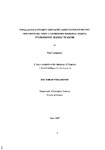POPULATION DYNAMICS AND FACIES ASSOCIATION OF RECENT FORAMINIFERA FROM A NEARSHORE MARGINAL MARINE ENVIRONMENT: PLYMOUTH SOUND
| dc.contributor.author | Castignetti, Paul | |
| dc.contributor.other | School of Biological and Marine Sciences | en_US |
| dc.date.accessioned | 2013-10-07T10:04:01Z | |
| dc.date.available | 2013-10-07T10:04:01Z | |
| dc.date.issued | 1997 | |
| dc.identifier | NOT AVAILABLE | en_US |
| dc.identifier.uri | http://hdl.handle.net/10026.1/2050 | |
| dc.description.abstract |
Plymouth Sound is an area of shallow marine to marginal marine sea approximately 10km² in size. It is situated on the South coast of England and partially restricted from the open ocean by the Breakwater. Its shallow marine waters are diluted by the outflow from two significant rivers; the Tamar and the Plym. All of these factors combined with the partial restriction of the Breakwater and open channels adjacent the Breakwater have created many different sub-environments within this small region. Very low energy to very high energy conditions are present, which range from normal marine, slightly hyposaline to moderately hyposaline. These varied sub-environments reflect many distinct foraminiferal assemblages, both living and dead. The live foraminiferal assemblages show great variation throughout the year in terms of abundance, diversity and number and style of reproductive events. The dead assemblage is relatively stable throughout the year. The assemblages from the different sub-environments reflect varying degrees of post-mortem alteration. A detailed study of the foraminiferal fauna reveals a complex interplay between energy conditions, sediment type, temperature and salinity which are reflected in the foraminiferal morphology, size and abundance. This is further complicated in the dead assemblages by post-mortem processes. The live assemblages were dominated by Ammonia beccarii batavus (Linne) which reached a maximum abundance of 1200 individuals per 100 cm³ and Elphidium crispum (Linne) which reached a maximum of 450 individuals per 100 cm³, other species were locally important such as Brizalina pseudopunctata (Hoglund) in the muds of the Breakwater (Location 9), which reached a maximum of 1600 individuals per 100 cm³. Production of species was very variable but production was highest during April/May, July and September/October. The dead assemblages are dominated by Cibicides lobatulus (Walker and Jacob), an exotic species, which testifies to considerable post-mortem transport. This species accounts for up to 60% of some assemblages. Ammonia beccarii batavus which accounts for up to 50% of some assemblages and Elphidium crispum which accounts for up to 30% of some assemblages. The vertical distribution of foraminifera within the various sedimentary facies and sub-environments was determined by the retrieval of nine sediment cores from six different facies over two years. The cores revealed that the greatest abundance of live foraminifera occurred in the uppermost centimeter/s of the sediment, particularly within muddy sediments. Cores for isotopic analysis were collected from three areas of the Sound and used to determined the sediment accumulation rate and date sediments down to approximately 50 centimeters. Sedimentation has been dynamic and discontinuous. Sediment accumulation rates range from 0.19 cm/per year to 0.48 cm/per year. In addition to the main foraminiferal study of the Sound the previously unstudied Plym Estuary was sampled. This revealed a typical low diversity calcareous fauna composed of Haynesina germanica (Ehrenberg) and Elphidium williamsoni Haynes which attained very high abundances of 4000 individuals per cm³. This study is the most recent of several spanning almost an entire century. Although the data from previous studies are limited, comparison of these previous studies with the present study indicate little change of foraminiferal species in recent time but potentially large changes, particularly in recent years, of foraminiferal abundance and biomass within the Sound. | en_US |
| dc.language.iso | en | en_US |
| dc.publisher | University of Plymouth | en_US |
| dc.title | POPULATION DYNAMICS AND FACIES ASSOCIATION OF RECENT FORAMINIFERA FROM A NEARSHORE MARGINAL MARINE ENVIRONMENT: PLYMOUTH SOUND | en_US |
| dc.type | Thesis | |
| plymouth.version | Full version | en_US |
| dc.identifier.doi | http://dx.doi.org/10.24382/3293 | |
| dc.identifier.doi | http://dx.doi.org/10.24382/3293 |
Files in this item
This item appears in the following Collection(s)
-
01 Research Theses Main Collection
Research Theses Main



